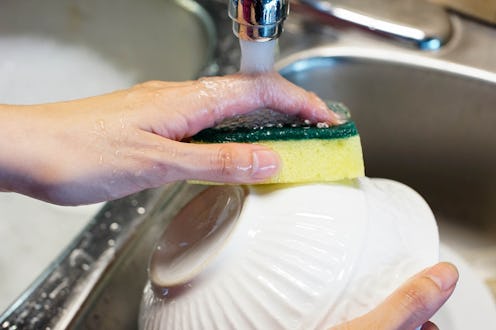Life
This Is How Often You Should Change Your Kitchen Sponges, According To Experts

When washing up, your main concern is ensuring pots, pans, dishes, and cutlery are spick and span. But one thing most of us forget is to inspect the tools that are doing the cleaning. Quite quickly, sponges can pick up all kinds of bacteria. So how often should you be changing your kitchen sponges? And is there a way to clean them, or are you resigned to purchasing new ones?
"That thing is very dirty," Philip Tierno, microbiologist and pathologist at the New York University School of Medicine, told Business Insider. "Mainly because you're cleaning up vegetables, carcasses of meat, and all sorts of food stuff that can potentially contain pathogenic bacteria that will grow in numbers over time."
In fact, a 2017 study, published in the Scientific Reports journal, found the five of the 10 most common bacterial groups found on kitchen sponges had the ability to cause a disease. Staph and strep infections from these bacterial types were also a possibility, though a less likely one.
Every time you use a sponge without cleaning it, bacteria builds up. It doesn't help that a damp setting, like the kitchen sink, is the ideal breeding place for bacteria, notes Well+Good. Leanne Stapf, who is now Chief Operating Officer at The Cleaning Authority, told the site that people should therefore be replacing sponges between once every fortnight to once a month.
The period depends on how often you use your sponge. If it's every single day, change it more often. If you regularly eat out, you can leave it a little longer. However, the aforementioned study suggested that people should consider changing kitchen sponges weekly.
To keep sponges looking as fresh as can be, try a cleaning method. Soaking a sponge in water and wringing out before gently microwaving it can eradicate some germs, states Well+Good. (Just be careful not to burn it — around two minutes should do.) Alternatively, soak sponges in a cup of vinegar or a cup of diluted bleach for five minutes.
This probably won't keep sponges entirely clean. The same 2017 study found that microwaving and boiling methods will only reduce around 60 percent of bacteria. Replacing is the only way to produce a completely fresh sponge.
Investing in biodegradable sponges can reduce the environmental impact of your new purchases. To save money, look for microfibre designs. According to Well+Good, these sponges can last up to two months for one simple reason. They dry quicker, potentially resulting in the presence of less bacteria.
Aside from the obvious grimy look, how do you know if your sponge needs a good clean, or if should be consigned to the bin? Check for a smell. If a nasty aroma begins to emanate from your kitchen tool, bacteria is having a field day, reports Self.
The more you clean your sponge, the longer it should last. Some even recommend cleaning after every use. A lot of effort, I agree, but worth it if you want to make the most of your purchase.